Is URL structure really matter for SEO? How to create a SEO-friendly URL? And how much it improves your SEO strength?
This topic has been discussed by many SEO experts for years. It’s critical to optimize your URL structure at the beginning when you first start your website. However, many bloggers and website owners do not include it in their SEO plan and end up using default URL structure which is worthless for SEO. I suppose reforming URL structure is one of the easy tasks in SEO checklist. Thus let’s learn how important URL structure is and learn some best practices to give your page a little boost in SERPs (search engine result pages).
Let’s start with some basics.
What Is URL Structure Or Permalink?
URL stands for uniform resource locator (or Universal Resource Locator – its original name) is not just to specify your website address but it is much more. In WordPress, URL structure is frequently interchangeably called permalink which is short for permanent links. Building a SEO-friendly URL structure offers a better browsing experience for users and helps search engines learn your page context and get it indexed more easily.
A standard URL structure consists of protocol, domain name and path (categories/ time/ numeric, post name/ author, etc)

Depending on URLs, they may contains many different parts and levels: Protocol (http, https), Subdomain, Domain name or SLD (second level domain), Top-level domain (TLD), Path, Fragment (or Hash/ Anchors), Parameters, etc. Below is an example of a more complicated URL and the analysis of its structure.
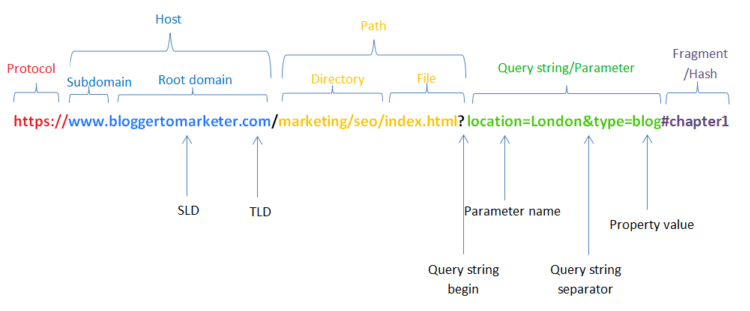
Just imagine your URL or permalink is your restaurant address.
- There are many features in your restaurant’s address like: number, street, city, zip code, state. Your standard URL structure would also consist protocol, domain name, category, post name.
- These features in the restaurant’s address are ordered in a specific hierarchy (name and street number first, zip code and state at the end). Similarly, you have to arrange your URL wisely. Create a standard hierarchy and stick to it for your entire pages.
- You shouldn’t change your restaurant’s address many times as it might get people confused. Similarly, you should have URL unchanged even you have your content update especially when your page is more than 6 months old or when it has already got much traffic. If you have your URL changed regularly, you get your customers and crawlers confused.
Why Is URL Structure Important For SEO?
Optimizing URL structure is considered one of the basic yet crucial step in SEO plan. There are various valid reasons why you should carefully consider keeping your URl structure organized and friendly.
For search engine to determine what your page is about
Search engines determine what your page’s content is about based on focus keywords placed in your URL structure. Also, a good URL “architecture” helps crawlers understand the structure of your pages and your site more accurately.
Moz and many SEO experts have listed domain-level keywords usage as one out of 10 influence of ranking factors in Google Algorithm.
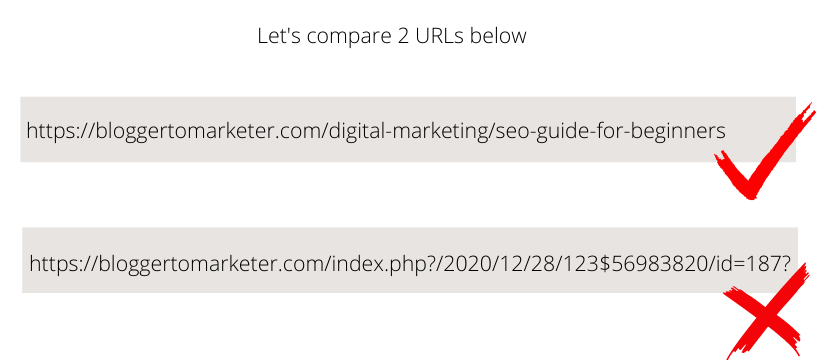
Obviously, the 1st is easier for crawlers to learn your page content. Besides, dates, numbers, special characters in the 2nd URL do not offer any strength to your SEO score, but instead it might confuse crawlers.
For ecommerce website:
A google URL structure helps crawlers to easily learn your site structure as well as know the relevant connections between different pages on your site, especially when it comes to categories or product groups. Let’s look at 2 URL structures below:
- https://junusi.com/apparels/t-shirts/pet-lovers-t-shirt
- https://junusi.com/apparels/hoodies/pet-lovers-hoodie
The crawlers will know how the pet lovers t-shirt and the pet lovers hoodies are related to each other since they belong to the same big category “apparels”.
Improves users experience.
It is suggested that you should fully consider alter the default URL structure to improve user experience. By looking at the URL, users expect to know what topic your page is about. A user-friendly URL structure is easy for users to navigate and to read.
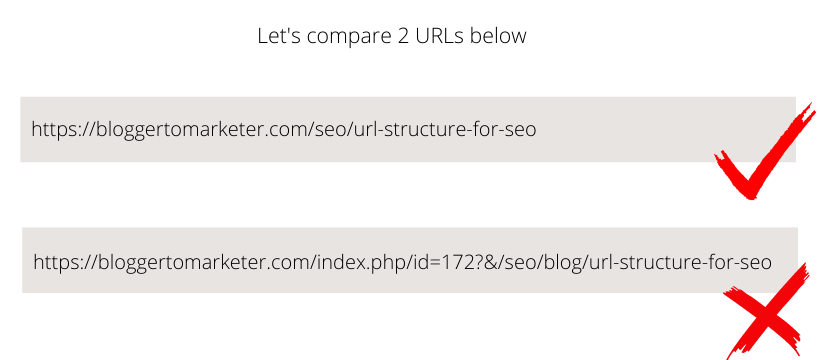
I world prefer the 1st one. At a glance, a user will instantly know where they are in your site and what to expect from the page. Also, it is easier for audience to remember, to read, and it is right to the point with the focus keywords.
Besides, when people share it on social media channels, the link looks clean and neat and hopefully compelling for people to click on.

URL Structure For SEO – Best Practices
In this part, we will list out some essential best practices to make sure you organize your URL structure wisely, which can help you strengthen your SEO score. Actually, you do not need to strictly follow all of them, it somehow depends on your business and your objective. But it is good to follow whenever possible.
#1. Keep your URL simple, short and readable
Make your URL as simple as possible, rewrite and customize the default permalink if it is so long or complicated. An optimized permalink is readable for both users and crawlers.
Make it easier for audience to understand and read and hopefully compelling enough for them to click on. Besides, when you share on social media, the link itself serves as anchor text, so make it friendly and readable.
And generally speaking, shorter URL structure is preferable. According to Backlinko, short URLs tend to outrank long URLs (around 40-100 characters is recommended)
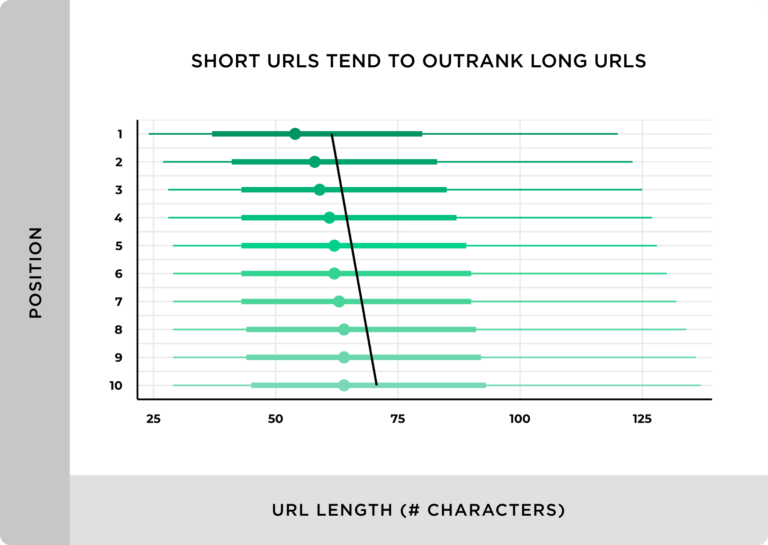
#2. Insert focus keywords into URL
Keywords used in URL is one of the features for SEO ranking. In point of fact, having keyword in the domain or URL doesn’t give you as much boost as it once did. But it is still considered as relevant and reliable signal of your site and your page.
Potential customer will get an idea of what your page’s content is about just by looking at the URL, as well as crawlers do.
#3. Make your focus keywords as close to the domain name as possible.
What do I mean by that, many SEO experts believe that it is better to have your keywords at the beginner of URL rather than in the middle or at the end. For example, my focus keywords are: “url structure for seo”, which URL should I opt for?

In the first URL structure, my focus keywords are at the end which is quite far from the domain name. Instead I would prefer the 2nd and the 3rd ones since I put my main keywords at the beginning; however, I would go for the 3rd one as it looks cleaner and shorter.
#4. Remove unrelated factors or extra words:
Avoid extraneous factors like dates and numbers or special characteristics (%, !, *, x, ?) because they not only confuse crawlers, but also offer no benefit to your SEO strength. In WordPress, the default format is usually included dates and post ID. You are advised to re-setup your permalinks at the beginning.
Many websites owners include the date in their URL structure. However, if your content is evergreen content which may still be valid 2 years or 5 years ago, then you better avoid including “year” in your permalink since it can be outdated after a while.
By the same token, many SEO experts believe that stop words (a, an, the, his, my, your, as, etc) add no value to search engines most of the time. And search engines mostly ignore stop words as they are smart enough to understand the context without them. It is a great idea to remove them to shorten your URLs and to make your URLs cleaner. However, no need to filter out all of stops word if it changes the meaning of the focusphrase in URLs.
#5. Avoid Parameter in URLs
Parameters are also referred as query strings and frequently used for tracking purpose in ecommerce businesses or advertising campaigns. Parameter query is a part of URL that follows by the question mark “?”, and using ampersand “&” as query string separators.
You are advised to avoid parameters in your URLs as much as possible. Including parameters in URL can create thousands of URL variations, which might create duplicate contents and other pitfalls, resulting confusing search engines and impacting SEO score.
A single URL for a single content is always recommended.

Google Search Central: Overly complex URLs, especially those containing multiple parameters, can cause a problems for crawlers by creating unnecessarily high numbers of URLs that point to identical or similar content on your site. As a result, Googlebot may consume much more bandwidth than necessary, or may be unable to completely index all the content on your site.
#6. Use hyphen to separate words in URL
Use hyphens (-) as words separators instead of underscore (_) or spaces ( ) or other special character to separate words since Google considers hyphen as a separator not a character and reads hyphens as spaces between your words.
If you use spaces or underscores, for instance, this is how human see URL with spaces: /url structure for seo best practice/
And this is how search engines read it /urlstructureforseobestpractice/. A series of words with no spaces will send a confusing signal to crawlers.
#7. Stick with lowercase letters:
It is better to write all of your URL with lowercase because in some cases, many versions of one URL can be considered as duplicate pages which causes duplicate content, like URL with upper case, lower case or capital letter. Besides, some servers treat URL as case sensitive So keep in mind that URL is case sensitive and lowercase is the preferred one.
#8. Optimize your URL from the title:
By default, WordPress will automatically generate your title into the permalink, but you have been noticed that sometimes your URL can be too long, too complicated, it includes many stops words and irrelevant characters. Thus you are supposed to optimize URL wisely by including only main keywords (4- 6 words is recommended).
For example: My title can be: URL structure for SEO – SEO for bloggers and beginners 2021
I will reform my URL by only including focus keywords /url-structure-for-seo/
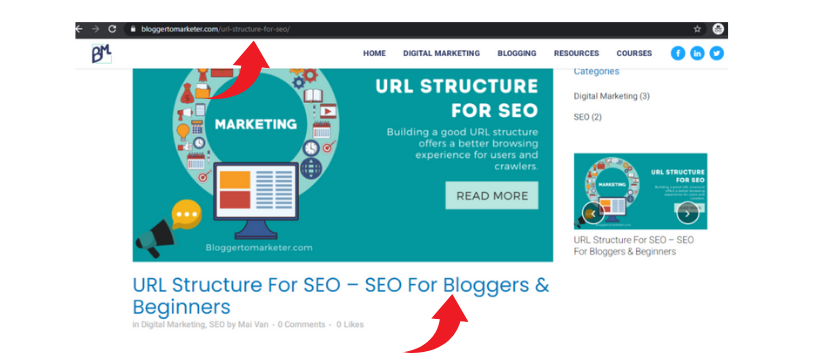
#9. Https as a ranking signal for SEO
It is confirmed by Google that https instead of http is an important ranking factor since security has become Google’s one of the top priority since 2014. Google encourages all website owners to adopt https (a more secure form of http) for their site to keep it safe for everyone and to empower your site ranking since Google might strengthen SEO for https over the time.
Thus, it is better to Use hosts that integrate SSL and configure HTTPS. If your domain is still “http”, you should get an SSL certificate for it.
#10. Follow a standard structure for your entire site:
As mentioned, the structure helps crawlers to learn your site easily, so determine what is your URL structure, what categories, subcategories that you want to be included and stick with this structure for your entire pages. However, you might not want to include too many subcategories or unnecessary information in your URL.
You can easily set up your permalinks in WP settings area settings => permalinks and choose a consistent structure for your pages. Use custom permalink where you can design your own structure.
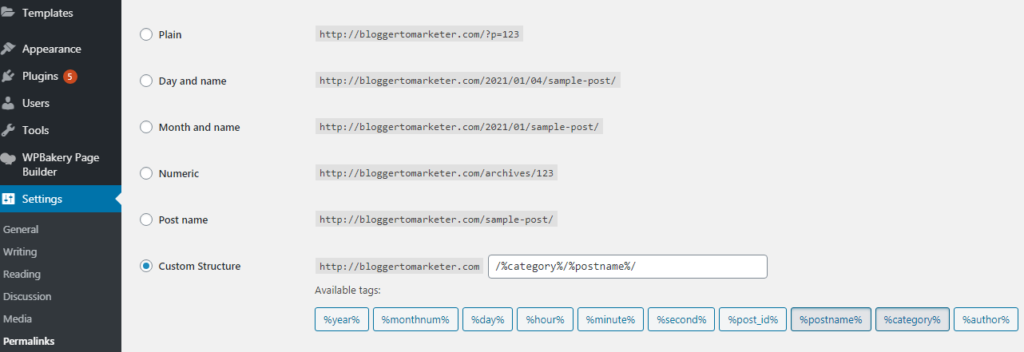
http://domain.com/%post-name%/ is most commonly used. Adding /category/ into your URL helps your user to know where they are in your site and it helps SEO by adding more keywords into your URL if your categories are your site keywords. However, sometimes, it is not recommended because it makes your URL longer. You decide how your site look but always keep in mind that:
- Do not opt for plain format since it is the least SEO-friendly structure.
- Use a single domain whenever possible.
- Don’t make your URL too long or too complicated by including too many information or categories.
- Avoid keyword stuffing in your URL.
#11. Don’t change your URL structure regularly:
If your site has been running for a while, let’s say more than 4 or 5 months and you have been striving too much to do SEO for your page. Then, don’t change your permalink structure because it may cause:
- Losing your social media share count
- Losing the data in analysis tools like Google Analytics since it considers as 2 different links.
- Your page might be marked as duplicate page, content, meta description.
- You might confuse crawlers and lose your existing SEO strength.
Hello and welcome to my creative space. I’m Mai! I am thrilled to have you visiting my blog. Wishing you all the best with your first website and your blogging journey. If my piece of writing is useful to you, you can invite me a coffee at beacons.ai/maivan. Lots of thanks!!


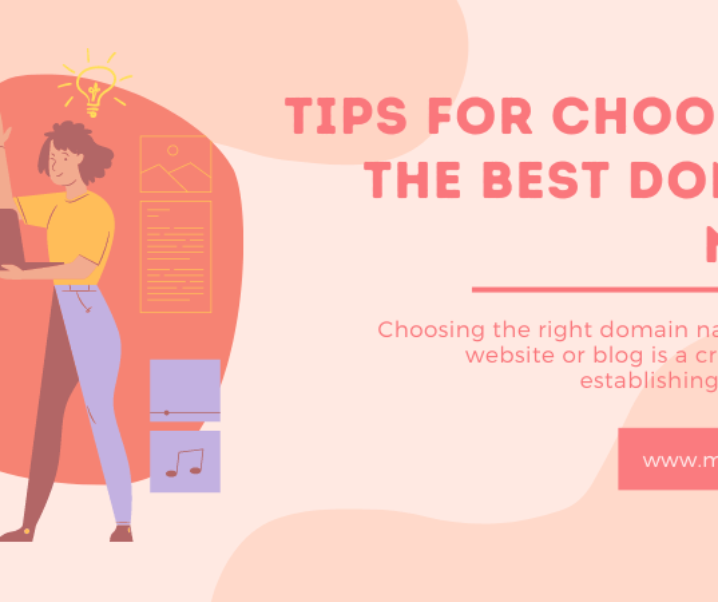


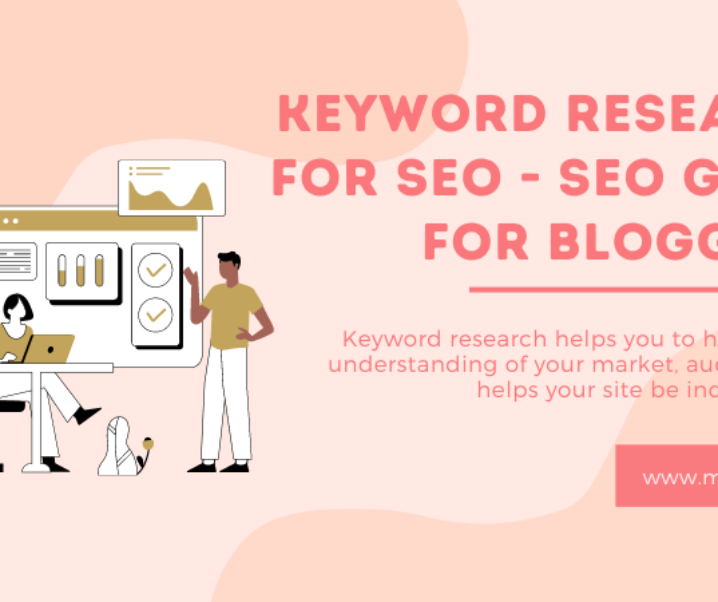



What do you think?